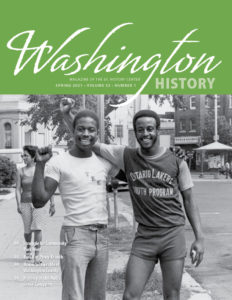
The spring issue of Washington History magazine, coming June 2021, fittingly offers stories of DC’s landscape, often a place of beauty as well as contention and mystery.
In celebration of the season, local environmentalist Steve Dryden offers a tour of the wonders of the Piney Branch watershed. Once the largest of Rock Creek’s tributaries, Piney Branch was a “setting of compelling natural beauty and a site of intriguing ecological complexity.” Home to a unique mix of woodland flora, the watershed enchanted poets and intrigued botanists and geologists. These scientists, many of them associated with Washington’s growing federal establishment, trekked through the area’s as-yet undeveloped groves and bogs, documenting what they found. The results of Piney Branch’s encounter with the ferocious and still unregulated land hunger of Washington’s early 20th-century housing market were predictable. Dryden documents the bulldozing of the brook’s magical glens and glades, and the diversion of this once “immortal force” into the “fetid darkness” of “a sewer dungeon under stone.” By re-calling the ethereal enchantments of this now-vanished environment, Dryden’s essay reminds us of the natural riches that remain to Washingtonians and that ask our stewardship.
Geographer Amanda Huron, an urban studies scholar at the University of the District of Columbia, and noted photographer Nancy Shia record the successful campaign of a band of kids calling themselves the Ontario Lakers who, working with neighbors in Adams Morgan, succeeded in grabbing a few acres of District land out of the maw of encroaching development to create a community park. Illustrated with images Shia captured in the 1970s and 1980s, Huron’s story is a parable of the limits and successes of one community effort to shape the city. As Huron recounts, the neighborhood that the Ontario Lakers vitalized with their success in establishing Community Park West has in intervening years been transformed by gentrification. Few of the families who took part in the effort remain in the neighborhood today to enjoy the park. Yet the park they created does remain, a permanent community space in a crowded District neighborhood—a testament to the possibilities of community effort and the importance of civic investment in the public realm. Huron and Shia’s work raises questions about how efforts like the Lakers’ might be nurtured and about how the impact of this kind of “caring in public” might be amplified both to support preservation of public space and to sustain shared access to it.
Blake Lindsey tours the hay fields and country roads of Civil War Washington County. Lindsey, a 2020-2021 U.S. Capitol Historical Society Capitol Fellow, looks beyond the boundaries of the old L’Enfant city to explore the Union Army encampments that tripled the population of Washington County in the years 1861-1865. Sites that are today grocery store parking lots and public-school playgrounds regain their earlier form in Lindsey’s conjuring as orchards and vegetable gardens. Union soldiers, many of them Yankee farm-boy provincials, assumed the worst of their new neighbors in “Secesh” Washington. And those neighbors, loyal or secessionist, found themselves subject to the depredations of an occupying army. Soldiers pillaged barnyards for provender and Army brass commandeered entire farmsteads for military use, with compensation always in doubt. Lindsey presents a Washington, which, then as now, is turbulent, divided, riven by faction and distrust and, sometimes, real danger.
Our issue closes with a scholar’s scavenger hunt, as architectural historian Sharon C. Park unwinds the story of three curious stone structures located today at 15th and Constitution Avenue. As Park explains, these structures—two gateposts and a gatehouse—were among a group of a couple dozen features designed in the 1820s by architect of the Capitol Charles Bulfinch. Initially incorporated as part of the wall ringing the Capitol grounds, the features were removed during the 1870s. Readers follow Park as she sorts through old records and scrutinizes antique images of downtown Washington to answer questions about when and why these ornaments were moved, and what became of them. The story of the gateposts’ perambulations is wrapped up with that of serial efforts to improve and redevelop downtown DC, so along the way are glimpses of the tumultuous development that seems to be one constant in the life of Washington.